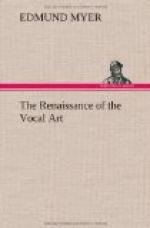Even in the palmiest days of the Old Italian School, there were forces at work which were destined to influence the entire vocal world. The subtle influence of these forces was felt so gradually, and yet so surely and powerfully, that while the profession, as one might say, peacefully slept, art was changed to artificiality. Thus arose that which may be called the dark ages of the vocal art,—an age when error overshadowed truth and reason; for while real scientists, after great study and research, discovered much of the true science of voice, many who styled themselves scientists discovered much that they imagined was the true science of voice.
Upon the theories advanced by self-styled scientists, many systems of singing were based, without definite proof as to their being true or false. These systems were exploited for the benefit of those who formulated them. This condition of things prevailed, not only through the latter part of the eighteenth century and the first half of the nineteenth, but still manifests itself at the present day, and no doubt will continue to do so for many years to come.
The vocal world undoubtedly owes much to the study and research of the true scientist. All true art is based upon science, and none more than the art of voice and of singing.
Science is knowledge of facts co-ordinated, arranged, and systematized; hence science is truth. The object of science is knowledge; the object of art is works. In art, truth is the means to an end; in science, truth is the end.
The science of voice is a knowledge of certain phenomena or movements which are found under certain conditions to occur regularly. The object of the true art of voice is to study the conditions which allow these phenomena to occur.
The greatest mistake of the many systems of singing, formulated upon the theories of the scientists, and of the so-called scientists, was not so much in their being based upon theories which oftentimes were wrong, as in the misunderstanding and misapplication of true theories. The general mistake of these systems was and is that they attempt by direct local effort, by direct manipulation of muscle, to compel the phenomena of voice, instead of studying the conditions which allow them to occur. In this way they attempt to do by direct control, that which Nature alone can do correctly.
While it is true that the vocal world owes much to science and the scientists, yet “the highest science can never fully explain the true phenomena of the voice, which are truly the phenomena of Nature.” The phenomena of the voice no doubt interest the scientists from an anatomical standpoint, but these things are of little practical value to the singer. As someone has said, “To examine into the anatomical construction of the larynx, to watch it physiologically, and learn to understand the motions of the vocal cords in their relation to vocal sounds, is not much more than looking at the dial of a clock; the movements of the hands will give you no idea of the construction of the intricate works hidden behind the face of the clock.”




